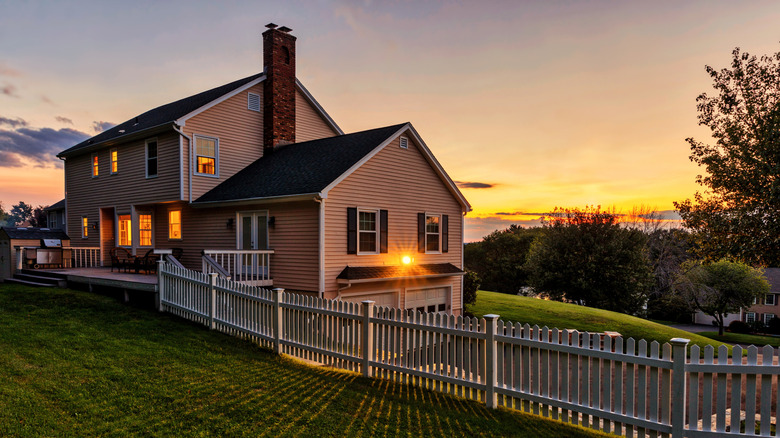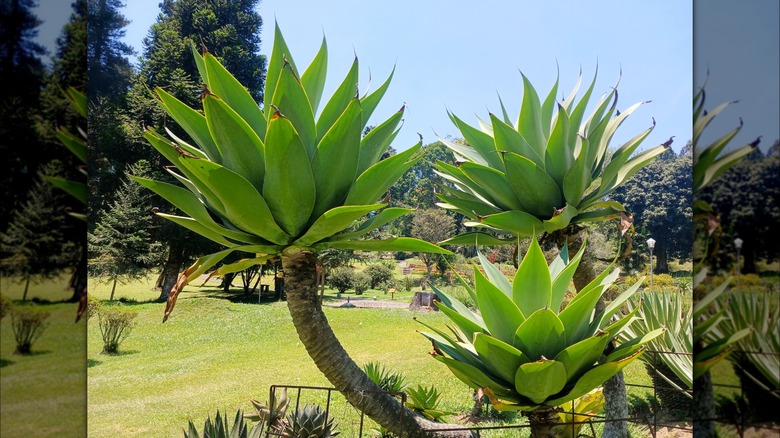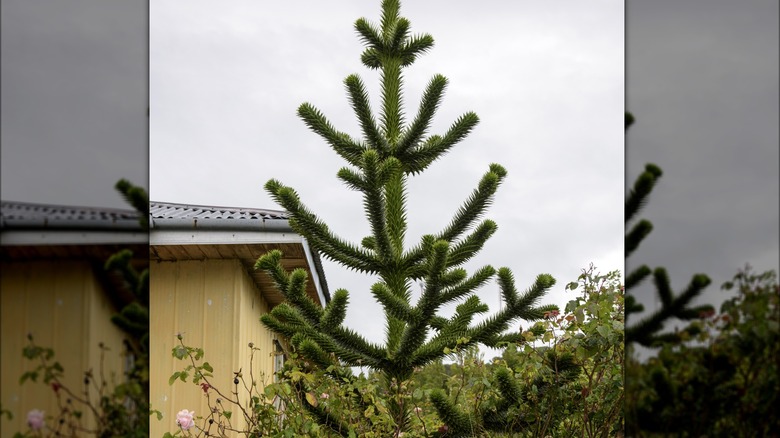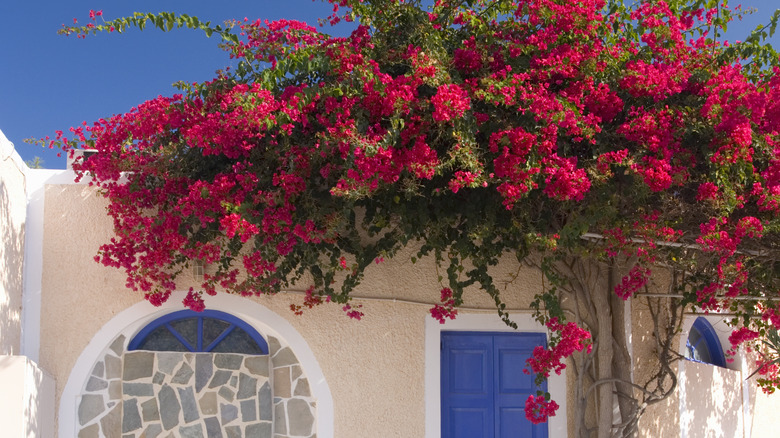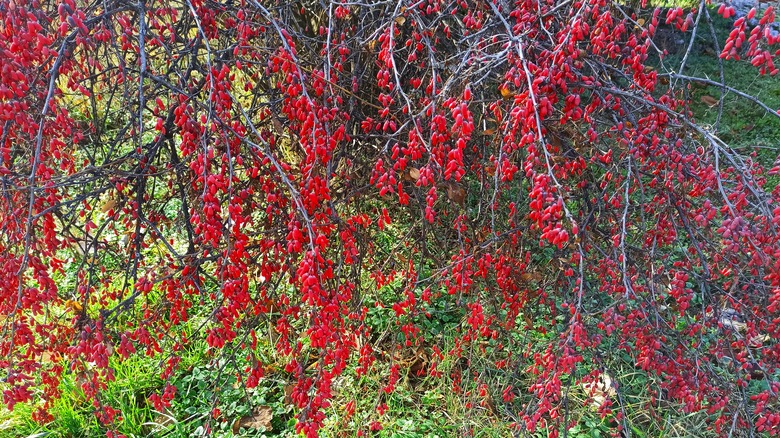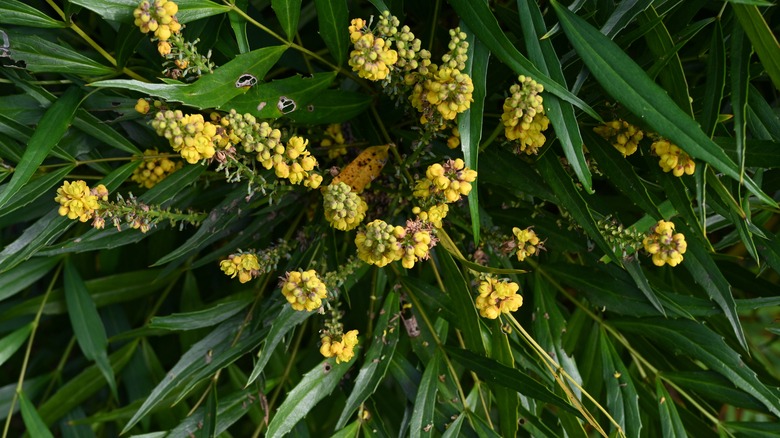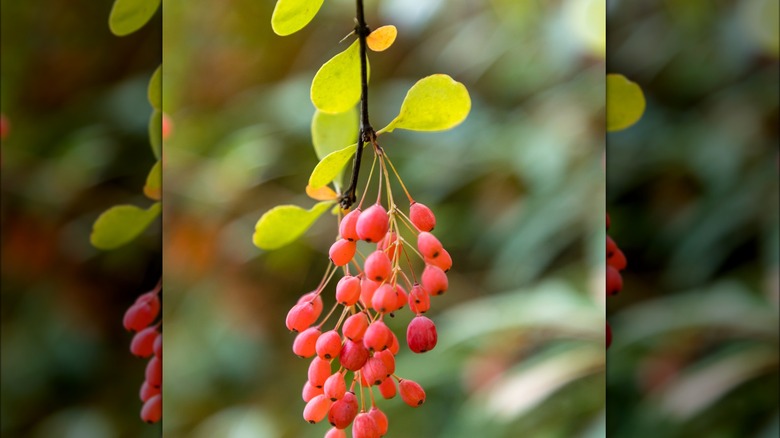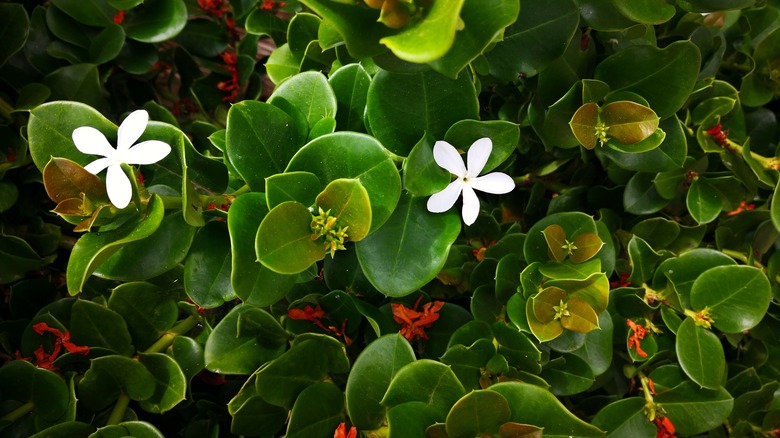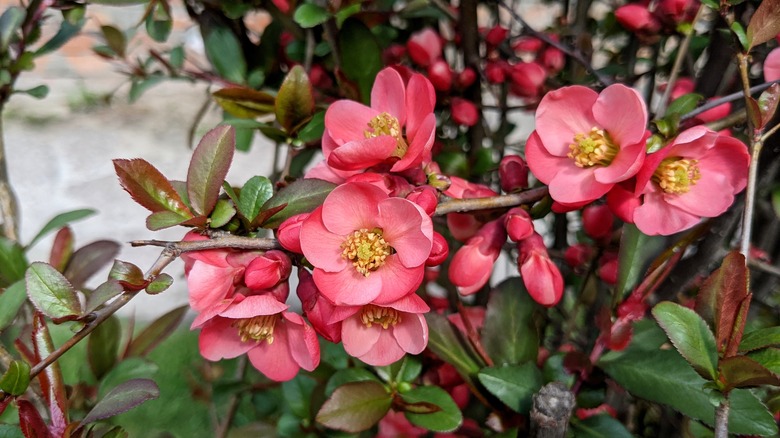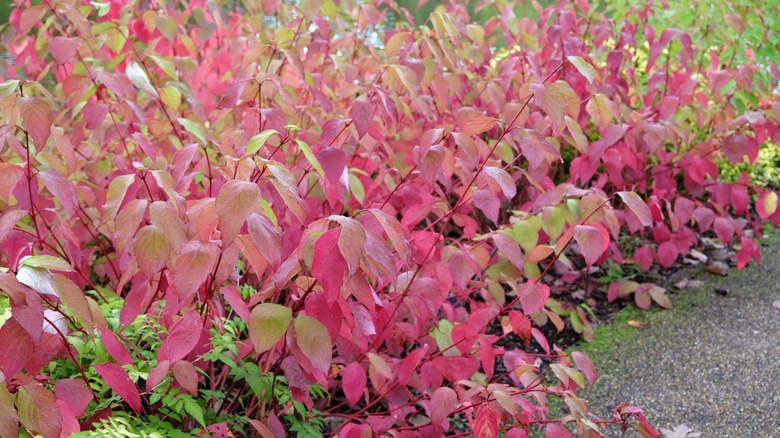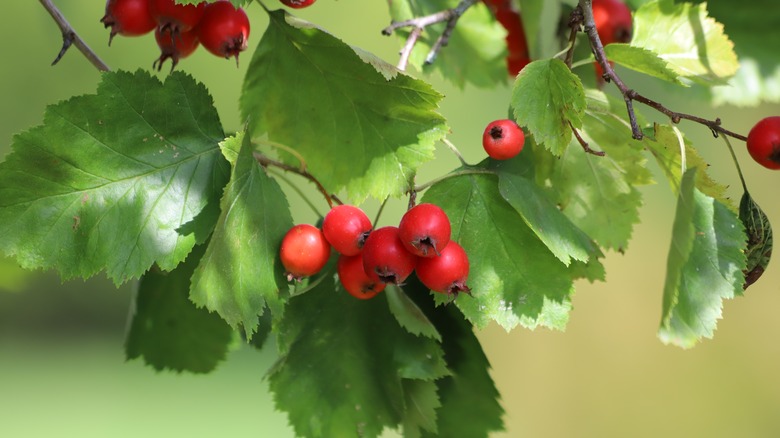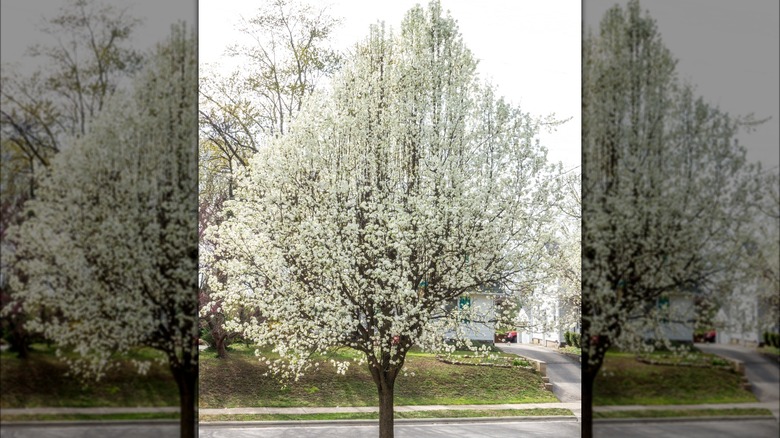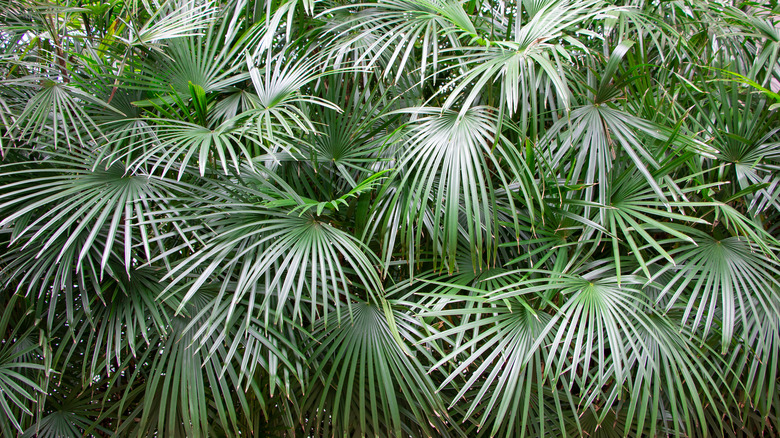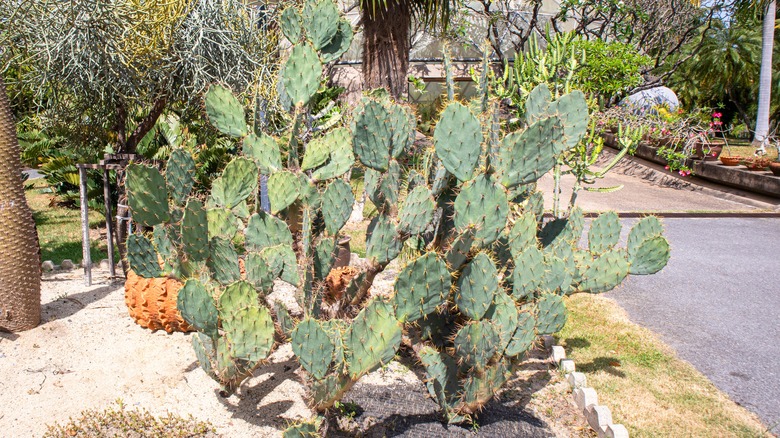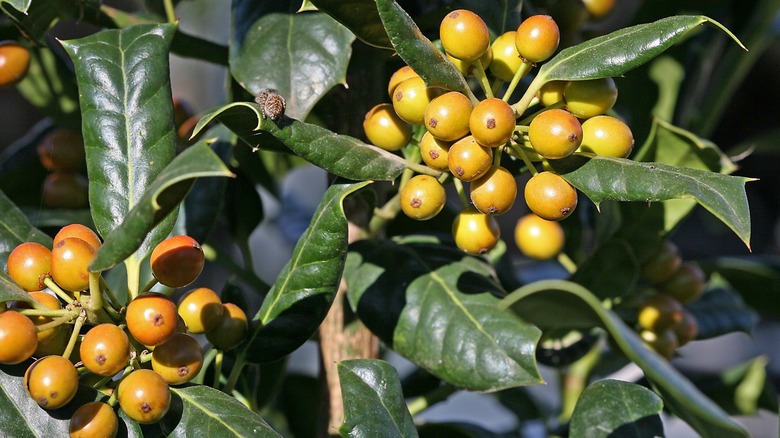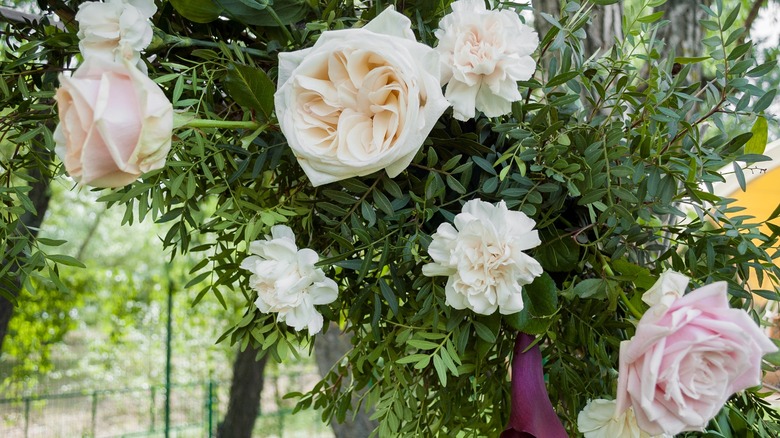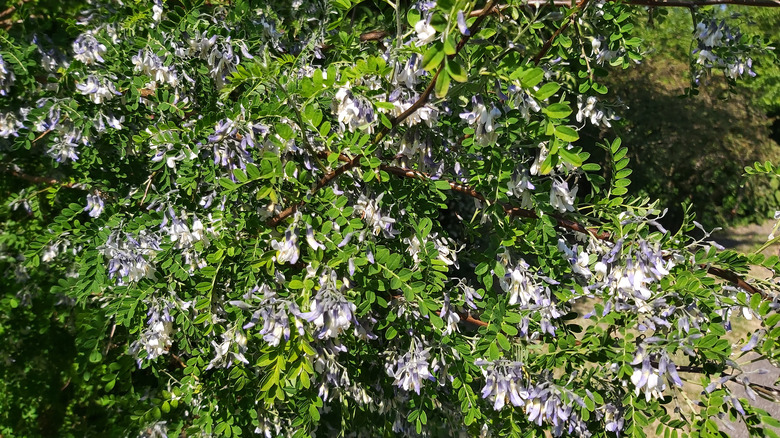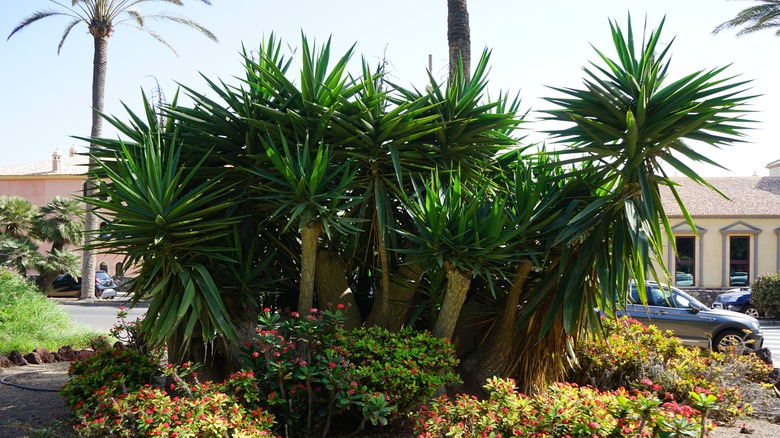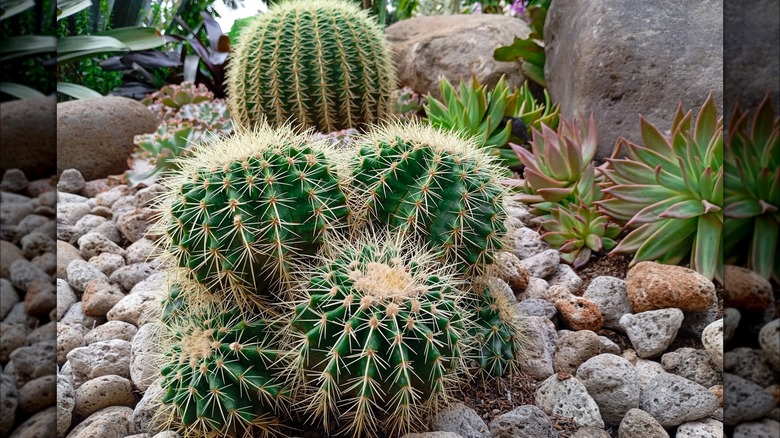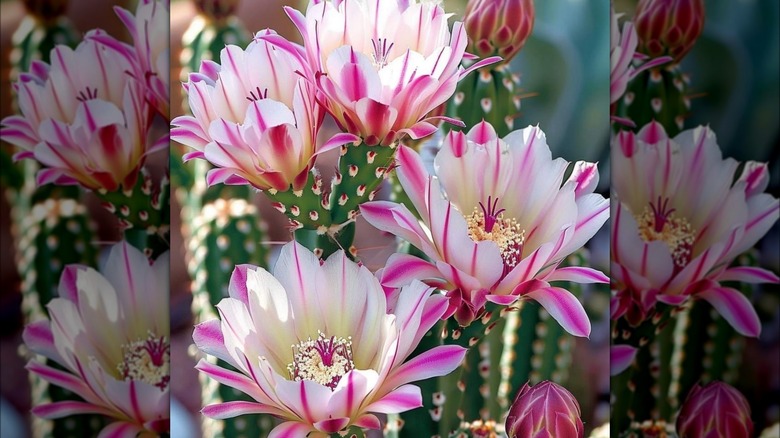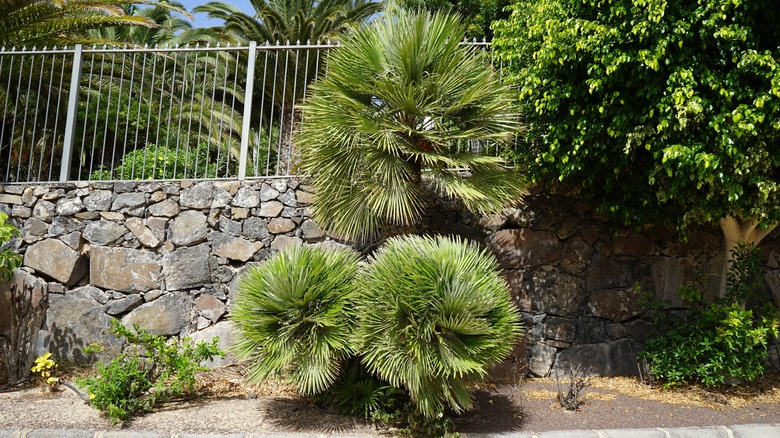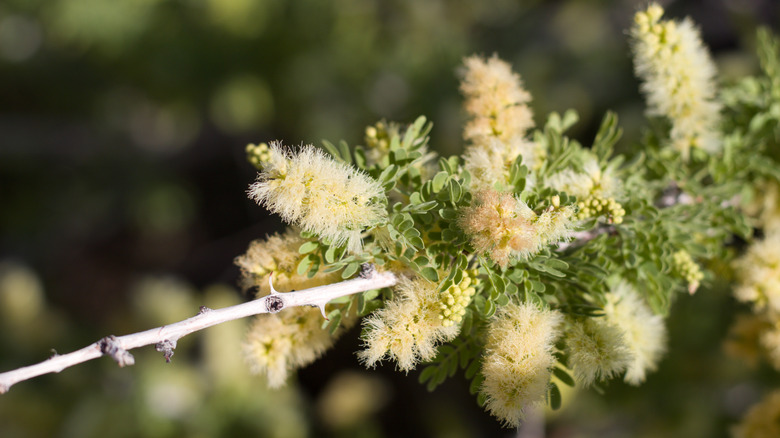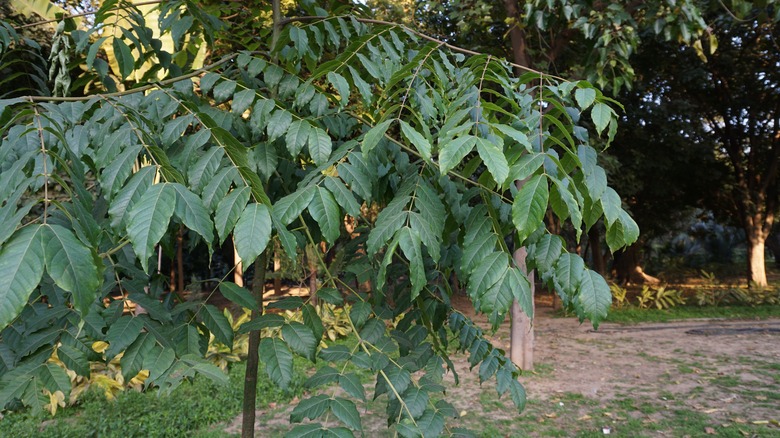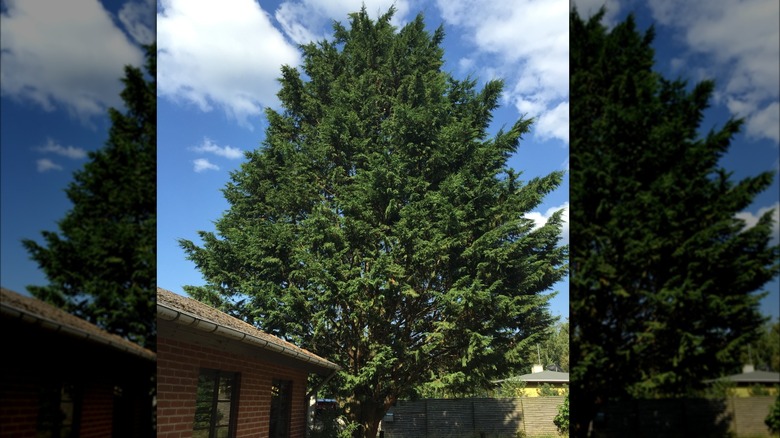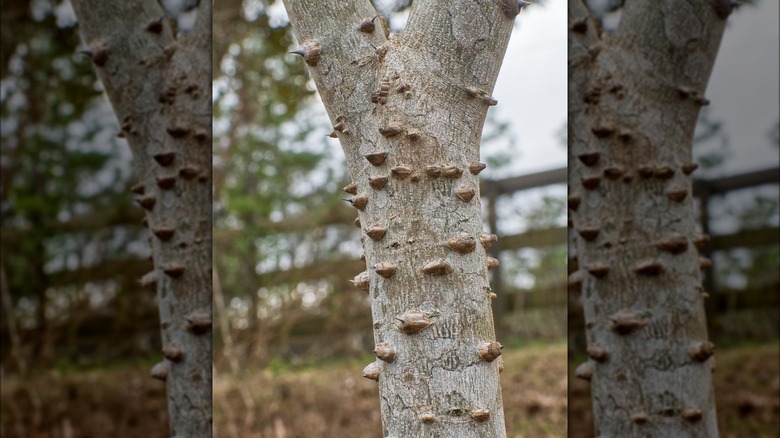Upgrade Your Home Security With These 24 Stunning Landscape Plants
From securing window latches and bolting exterior doors to activating floodlights, there's no dearth of inexpensive tips that can help protect your home from intruders. Many homeowners step up their safety game by installing security cameras and alarm systems, hoping it'll scare the burglars off. However, these lines of defense can and should be cemented even more by being deliberate about your landscaping. Prickly plants with wicked thorns, spines, or serrated leaves can often serve as operative deterrents since any accidental contact entails painful rashes and injuries, making unwelcome walk-throughs a hard pass. Agave, bougainvillea, hawthorns, plums, prickly pear cactus, rose bushes, and many more plants, as listed below, befit this purpose.
To ensure a meaningful impact, it's essential thorny shrubbery and trees are positioned strategically. For instance, to protect your home's rear, you can either plant prickly bushes underneath the windows (soil or containers) or train them over a fence to create a security barrier. Follow the 3-8 landscaping rule, wherein hedges are pruned to 3 feet (knee-height) while trees are at least 8 feet high, especially in the front yard. This will keep the area sufficiently open, ensuring sightlines aren't blocked and airflow remains adequate. Read on to learn about 24 stunning landscape plants that help upgrade home security.
1. Agave
The agave or century plant's heat and drought resistance has become a staple in xeriscapes and waterwise gardens in USDA zones 9 to 11. But its real sheen comes out behind the rear windows, provided it receives copious sun and gets to stand on gritty soils. Its glaucous rosette of fleshy leaves with pointed tips and spiny margins is sure to give most crooks a pause. Besides, direct contact will cause contact dermatitis. Pulque Agave (A. salmiana), American Aloe (A. Americana), and Octopus agave (A. vilmoriniana) are the most popular options for home security.
2. Monkey-puzzle tree
Security landscaping requires the yard space to remain open so that trespassers have no place to hide, and if they risk it anyway, spotting them stays easy. Monkey-puzzle trees (Araucaria Araucana) or Chilean pines, with their sparse, pyramidally-arranged, rope-like branches, promise this level of openness while concurrently adding a unique texture to the yard. Besides, their leafy tips are sharp and pointed, so rest assured grazing past them would leave painful marks. They extend upwards of 20 feet, so give them ample space. However, keep them away from sidewalks or structural elements as they generate surface-level roots.
3. Bougainvillea
Climbing plants you should grow on your property include the likes of bougainvillea, especially its spectabilis variety. Besides adding an ornamental touch with their non-stop flowery display in varied gold, pink, and red hues, they prime security with their thorns. Train their woody vines over a trellis, fence, or wall in backyards to create a barbed deterrent, assuming they receive over six hours of sunlight and support acidic soils. Otherwise, pop the bougainvillea vines in containers and style them into shrubbery. They're cold hardy to USDA zones 9 to 10 and measure over 15 feet top and across.
4. American barberry
Native to the eastern region of the North American continent, American barberry (Berberis canadensis) is a pollinator-friendly, deciduous stunner that bolsters home security. Unpruned, it grows over 6 feet tall, making it appropriate as a perennial hedge. Its burgundy stems are riddled with three-pronged spines, while the whorled leaves support coarse, serrated margins, sure to leave anyone prickly. It's an easy-care shrub that settles for most soils, including clay, sand, and loam, whether dry or moist. However, it does send out suckers in favorable conditions, so be prepared to pull them out if you don't want them naturalizing.
5. Fortune's mahonia
Fortune's mahonia (Berberis fortunei) is a non-invasive Chinese import that's become popular with hummingbirds, bees, and butterflies for its perfumed yellow blooms and reddish-purple berries that appear from summer-end through early winter. However, as the slow-growing perennial matures to around 3 to 5 feet wide mound, it behooves itself as a security hedge in zones 7 to 9. Plonk it in a sheltered position (away from winds), though. Fortune's mahonia burgeons numerous spines (much like a holly tree) on its evergreen, fern-like foliage, adding major deterrence value. It's a shade-lover, tolerating everything from dappled to heavy shadows.
6. James barberry
If herbivory is an unending problem in your property, grow James barberry (Berberis jamesiana), a deciduous shrub hailing from Asia. It welcomes spring with wisps of yellow petals, charming scores of pollinators. Plus, it keeps the visual interest going by setting cream fruits that mature into beautiful salmon or red shades in the fall. The plant grows 10 feet high, though this may take over five years. Use it as a hedge or mass along unprotected walkways to let intruders taste the 2-inch-thick thorns sticking out of its olive foliage. It's hardy in zones 5 to 9.
7. Natal plum
You might know the natal plum (Carissa macrocarpa, formerly Carissa grandiflora) as a popular type of bonsai tree that'll add a dramatic flair to your indoor space. But it does an incredible job of reinforcing home security, courtesy of its sharply pointed, spiny leaves that persist year-round. They're best grown outside back windows that may become entry pathways for crooks. But ensure you keep them pruned for the day when you might have to escape a fire hazard. They require moist, organically rich soils and can be grown in containers if soil conditions remain unmet. Additionally, give them full sun.
8. Flowering quince
At home in USDA zones 5 to 9, flowering quince or red chief (Chaenomeles hybrids) is a thorn-bearing deciduous shrub that can be planted around patios, walkways, or foundation beds to pre-empt bad actors. Other times, it can be enjoyed for its scarlet red flowers that add to the Christmas cheer as they glisten against the snowy backdrop. Flowering quinces also produce fragrant fruits in autumn, exhibiting their versatility. Grow them in a part-to-full sun and watch them grow 6 feet tall. You'll need to shear off the old stems to force the plants to bush out.
9. Red twig dogwood
In low-lying marshy areas, clay sites, or cold wind-exposed spots of your yard, consider growing red twig dogwood (Cornus sericea). Endemic to most of the U.S., these fast-growing deciduous shrubs soar over 6 feet and are mass-planted to create a dense thicket. They're quite the stunners, too, brightening summers with white flowers and berries, enjoyed by native bees, butterflies, and songbirds. Their lanceolate green leaves turn a burnished red or purple in the fall, yet aren't missed after they're shed, as the shrub supports red stems through the winter. Grow them in full sun or partial shade.
10. Copenhagen hawthorn
Endemic across the east U.S., Copenhagen or entangled hawthorn (Crataegus intricate) is another deciduous shrub whose thorns ensure security — your home's and for the birds sheltering in it. Its wedge-shaped leaves pack into dense, multi-stemmed thickets measuring around 10 feet. Copenhagen hawthorn tolerates dappled to partial shade, though its best performance comes out in full sun. It also adapts to alkaline soils but is fixated on good drainage. Since it's unaffected by winds (except salt sprays), it can be a decent addition in open sites. It might shoot out suckers, so occasional root pruning may be pertinent.
11. American plum
Planted for its ornamental value rather than its fruit, American or wild plum (Prunus americana) can be trained to grow as a security tree. Its reddish-brown stems split into thorny side branchlets laden with toothed leaves, promising some protection. It adds a splash of color and fragrance to the property with white umbels and purplish-red fruits, attracting pollinators and songbirds. Unfortunately, deer browse its foliage, so you may've to skip it in case their presence is already problematic. Ensure it receives at least two hours of sun exposure and pull out any suckers to keep it contained.
12. Needle palm
Use porcupine or needle palm (Rhapidophyllum hystrix) to create a low-growing, evergreen dense cover. But be ready to deal with its spines in exchange for putting off uninvited guests. Needle palms grow out nearly 10-inch-long spines from their glossy sheaths, which means pruning or removing any errant suckers will be a tall task. Naturally, it deters deer from venturing inside your property as well, although rodents will go gaga over the thorny winter shelter. They're cold hardy in growth zones 6 through 10, with mulch for winter protection. They prefer moderate shade and put up with wet substrates.
13. Prickly pear cactus
You should grow a prickly pear cactus next to your windows if you're lousy about keeping them shut. Botanically called Opuntia, prickly pear cacti have over 3-inch-long spines protruding from their green pads. While they're aimed at defending against the plants' pests, these spines bequeath painful blisters on intruders, too, becoming pivotal to home security. Not to mention, they're covered in numerous petite prickles that leave the skin itchy, sure to incite exasperation. They're suitable in zones 3 through 11 in full sun sites. Lean, sand, and acidic soils are preferred. Don gloves before touching the cacti!
14. 'Nellie R. Stevens' holly
Interbreeding cornuta and aquifolium varieties has birthed a hybrid holly cultivar: 'Nellie R. Stevens' (Ilex 'Nellie R. Stevens'). It's a fast grower, touching 25 feet across and similarly tall at maturity. Since its polished evergreen foliage is punctuated and ends in spines, it works as a security plant in and around your home. Use it around foundation beds or as a living hedge in spots missing a picket fence. Unlike other holly trees, Nellie R. Stevens doesn't require a male pollinator to produce her winter-persisting ornamental berries that are all the rage with songbirds.
15. Memorial rose
Drape your backyard wall or fence with a rambling rose variety like the memorial rose (Rosa lucieae). While it doesn't offer dense coverage, it creates a protective barrier because of the multiple prickles coating its lustrous, semi-evergreen foliage. It looks pretty from spring through summer when its white flowers and red hips are out in their full glory, attracting the attention of bees. Fortunately, it's mildew-resistant, a trait hard to find amongst most rose varieties. Plant memorial roses in a sunny site containing well-draining soils to coax them into growing around 15 feet wide in zones 5 to 8.
16. David's mountain laurel
Another way to create a deterrent barrier around your property is to grow David's mountain laurel (Sophora davidii). Not only does this 6-foot-tall deciduous shrub pack into a dense thicket, but it also supports plenty of disagreeable spines all over its branches that intruders wouldn't want puncturing their skin. Besides, it's a beauty in its own right, pushing out bluish-green foliage that's attractive for most of the year. Pale blue flowers and copper fruits sprinkle spring through fall color. Drought- and heat-tolerant mountain laurels thrive in zones 5 to 9, exposed to full-to-part sun.
17. Yucca
Armed with lance-like, evergreen leaves, yuccas lend a xeric feel and textural contrast to any yard. Their appearance is appreciably softened by the creamy white flower spikes that burst out by spring end. While gardeners may be tempted to stick to varieties native to their area, ensure you plant a thorn variety if the aim is to augment your home security. For instance, Floridian denizens can look for varieties like the Spanish bayonet or Adam's needle. Yuccas are suitable around dry, sunny sites with good drainage. They send across lateral shoots, spanning 3 feet wide by maturity.
18. Golden barrel
To make your intentions clear that trespassers are unwelcome, consider plopping a golden barrel (Echinocactus grusonii) as an accent or specimen in your backyard. Match it with rocks or boulders for a more decorative touch. It has a light green, 5-foot-wide cylindrical body, which is stippled in copious yellow spines, highlighting its role as a security plant. Plus, it brings in bees and birds during summer when it blooms yellow flowers and auburn fruits. It's easy to maintain, requiring monthly watering at most. While it enjoys full sun, overhead watering can make it susceptible to scorch or fungal infections.
19. Argentine giant
Looking for a plant that looks right out of the desert, lends the feel of a night garden, and can hurt anyone who dares cross it? Go for the Argentine giant (Echinopsis candicans), an evergreen plant that crops out multiple radial spines to go along its main spine. While its singular white flowers barely last over a day, they bloom so profusely in waves during late spring that it's easy to forget the Argentine giant is a cactus. They're low maintenance, generally doing away with supplemental irrigation and requiring pruning every couple of years.
20. European fan palm
Add Tuscan rizz to your backyard with Mediterranean or European fan palms (Chamaerops humilis). Their bluish-to-silverish-green fronds span out like a fan from coarse, gray bark and pack a barbed punch with their needle-shaped spines. As they grow slowly, they don't require much from a maintenance point of view. Just ensure they're sited in organically rich soils that are fully exposed to the sun. If not, give them partial shade at the very least. They're winter hardy through zone 8 and can be mass-planted to create a security hedge. You may also pop them in patio containers.
21. Catclaw acacia
Prevalent across the southwest U.S., growing catclaw acacia (Acacia or Senegalia greggii) is a fine way to thwart intruders. Among other alternate names, including paradise flower and devil's claw, it's also called wait-a-minute bush. The reason? Its stems produce a plethora of spines, nearly identical-looking to cat's claws, compelling passersby to spend time untangling themselves unless they wish to risk tearing their outfit. The spring-blooming, semi-deciduous shrubs tolerate temperature dips to 15 degrees Fahrenheit. They survive in rocky or sandy textures but prefer fast-draining, alkaline soils. Position them in full sun.
22. Devil's walking stick
Native throughout the east U.S., the devil's walking stick (Aralia spinosa) is a 10-foot-tall shrub or tree, best popped in woodland sites. It adds multi-season decorative interest through white umbels, fall-changing foliage, and purplish-black drupes that a bevy of butterflies and songbirds adore. As the perennial's stems are ringed with spines and contact with its bark and fruits causes skin irritation, it's an important addition from the security perspective. However, it's a generous producer of suckers, which may become problematic if you don't stay on top of your weeding game. Plant in full-to-part sun, away from cold snaps.
23. Green giant arborvitae
Several positive attributes have been bred into green giant arborvitae (Thuja 'Green Giant') — a hybrid mix of redcedar and Japanese arborvitae. Barring salt sprays, it easily tolerates droughts, deer pressure, and pests. It adapts to most soils, including shallow-rocky and clay, and survives in partial shade to full sun. Pruning is more of a rare occurrence, as it's usually great at maintaining its needled, pyramidal shape. Grouping multiple plants establishes an evergreen hedge that even birds may nest in. However, it's a fast grower and can extend nearly 18 feet wide, so ensure it has adequate room.
24. Southern prickly ash
In woodland sites, consider adding southern prickly ash (Zanthoxylum clava-herculis) or Hercules-club. Typically, it stays under 30 feet tall and 25 feet across in home settings but poses a danger to unexpected visitors through its spiny bark. It's endemic to the southeast U.S., yet thrives in zones 7 to 9. It isn't the most ornamental citrus tree, but it perfumes the landscape anytime its foliage, flowers, or bark are crushed. It's disease- and pest-resistant, but swallowtail butterflies can cause massive defoliation during their mothering days. Impoverished or sandy soils are tolerated. Remove any volunteer suckers to limit spread.
